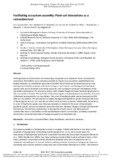JavaScript is disabled for your browser. Some features of this site may not work without it.
| dc.contributor.author | van der Bij, A. U. | |
| dc.contributor.author | Weijters, M. J. | |
| dc.contributor.author | Bobbink, R. | |
| dc.contributor.author | Harris, Jim A. | |
| dc.contributor.author | Pawlett, Mark | |
| dc.contributor.author | Ritz, K. | |
| dc.contributor.author | Benetková, P. | |
| dc.contributor.author | Moradi, J. | |
| dc.contributor.author | Frouz, J. | |
| dc.contributor.author | van Diggelen, Rudy | |
| dc.date.accessioned | 2018-03-07T09:43:47Z | |
| dc.date.available | 2018-03-07T09:43:47Z | |
| dc.date.issued | 2018-02-23 | |
| dc.identifier.citation | van der Bij AU, Weijters MJ, Bobbink R, Harris JA, Pawlett M, Ritz K, Benetková P, Moradi J, Frouz J, van Diggelen R, Facilitating ecosystem assembly: Plant-soil interactions as a restoration tool. Biological Conservation, Volume 220, Issue April, 2018, pp. 272-279 | en_UK |
| dc.identifier.issn | 0006-3207 | |
| dc.identifier.uri | http://dx.doi.org/10.1016/j.biocon.2018.02.010 | |
| dc.identifier.uri | http://dspace.lib.cranfield.ac.uk/handle/1826/13051 | |
| dc.description.abstract | Although plant-soil interactions are increasingly recognized as an important factor in ecosystem restoration, their effects on community assembly during de novo ecosystem establishment are largely unknown. In a heathland restoration trial after topsoil removal we introduced either only aboveground heathland species with fresh herbage or both above- and belowground heathland species with sods to facilitate community assembly. Sod inoculation increased resemblance of the microbial community to the reference system, with a higher fungal and lower bacterial proportion to the community structure. Also densities of bacteriophagous and phytophagous nematodes, Acari and Collembola increased after sod inoculation. The cover of heathland plant species increased by 49% after sod inoculation. The introduction of solely aboveground heathland species increased the cover of these species by only 13%, and did not affect soil community assembly. Additionally, the increase in cover of heathland species over time was inversely correlated to the cover of mesotrophic grassland species. Inverse correlations were also observed between changes in fungal and bacterial abundances. Simultaneous introduction of key species of both above- and below-ground communities had a critical effect on the establishment of both communities, providing a potential shortcut for successful restoration of target ecosystems on disturbed soils. | en_UK |
| dc.language.iso | en | en_UK |
| dc.publisher | Elsevier | en_UK |
| dc.rights | Attribution-NonCommercial-NoDerivatives 4.0 International | * |
| dc.rights.uri | http://creativecommons.org/licenses/by-nc-nd/4.0/ | * |
| dc.subject | Restoration | en_UK |
| dc.subject | Ecological filters | en_UK |
| dc.subject | Fungi | en_UK |
| dc.subject | Heathlands | en_UK |
| dc.subject | Mesofauna | en_UK |
| dc.subject | Bacteria | en_UK |
| dc.title | Facilitating ecosystem assembly: Plant-soil interactions as a restoration tool | en_UK |
| dc.type | Article | en_UK |
| dc.identifier.cris | 19720491 |
Files in this item
The following license files are associated with this item:
This item appears in the following Collection(s)
-
Staff publications (SWEE) [2827]

